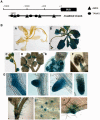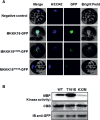Arabidopsis ABA-Activated Kinase MAPKKK18 is Regulated by Protein Phosphatase 2C ABI1 and the Ubiquitin-Proteasome Pathway
- PMID: 26443375
- PMCID: PMC4675898
- DOI: 10.1093/pcp/pcv146
Arabidopsis ABA-Activated Kinase MAPKKK18 is Regulated by Protein Phosphatase 2C ABI1 and the Ubiquitin-Proteasome Pathway
Abstract
Phosphorylation and dephosphorylation events play an important role in the transmission of the ABA signal. Although SnRK2 [sucrose non-fermenting1-related kinase2] protein kinases and group A protein phosphatase type 2C (PP2C)-type phosphatases constitute the core ABA pathway, mitogen-activated protein kinase (MAPK) pathways are also involved in plant response to ABA. However, little is known about the interplay between MAPKs and PP2Cs or SnRK2 in the regulation of ABA pathways. In this study, an effort was made to elucidate the role of MAP kinase kinase kinase18 (MKKK18) in relation to ABA signaling and response. The MKKK18 knockout lines showed more vigorous root growth, decreased abaxial stomatal index and increased stomatal aperture under normal growth conditions, compared with the control wild-type Columbia line. In addition to transcriptional regulation of the MKKK18 promoter by ABA, we demonstrated using in vitro and in vivo kinase assays that the kinase activity of MKKK18 was regulated by ABA. Analysis of the cellular localization of MKKK18 showed that the active kinase was targeted specifically to the nucleus. Notably, we identified abscisic acid insensitive 1 (ABI1) PP2C as a MKKK18-interacting protein, and demonstrated that ABI1 inhibited its activity. Using a cell-free degradation assay, we also established that MKKK18 was unstable and was degraded by the proteasome pathway. The rate of MKKK18 degradation was delayed in the ABI1 knockout line. Overall, we provide evidence that ABI1 regulates the activity and promotes proteasomal degradation of MKKK18.
Keywords: ABA signaling; ABI1 PP2C; Arabidopsis thaliana; MAP kinase cascade; MKKK18; Proteasome.
© The Author 2015. Published by Oxford University Press on behalf of Japanese Society of Plant Physiologists.
Figures










Similar articles
-
The Arabidopsis mitogen-activated protein kinase phosphatase PP2C5 affects seed germination, stomatal aperture, and abscisic acid-inducible gene expression.Plant Physiol. 2010 Jul;153(3):1098-111. doi: 10.1104/pp.110.156109. Epub 2010 May 20. Plant Physiol. 2010. PMID: 20488890 Free PMC article.
-
Regulation of Arabidopsis MAPKKK18 by ABI1 and SnRK2, components of the ABA signaling pathway.Plant Signal Behav. 2016;11(4):e1139277. doi: 10.1080/15592324.2016.1139277. Plant Signal Behav. 2016. PMID: 26852793 Free PMC article. Review.
-
AIK1, A Mitogen-Activated Protein Kinase, Modulates Abscisic Acid Responses through the MKK5-MPK6 Kinase Cascade.Plant Physiol. 2017 Feb;173(2):1391-1408. doi: 10.1104/pp.16.01386. Epub 2016 Dec 2. Plant Physiol. 2017. PMID: 27913741 Free PMC article.
-
Phosphatase ABI1 and okadaic acid-sensitive phosphoprotein phosphatases inhibit salt stress-activated SnRK2.4 kinase.BMC Plant Biol. 2016 Jun 13;16(1):136. doi: 10.1186/s12870-016-0817-1. BMC Plant Biol. 2016. PMID: 27297076 Free PMC article.
-
Protein phosphatase 2C (PP2C) function in higher plants.Plant Mol Biol. 1998 Dec;38(6):919-27. doi: 10.1023/a:1006054607850. Plant Mol Biol. 1998. PMID: 9869399 Review.
Cited by
-
Weighted gene co-expression network analysis unveils gene networks associated with the Fusarium head blight resistance in tetraploid wheat.BMC Genomics. 2019 Dec 3;20(1):925. doi: 10.1186/s12864-019-6161-8. BMC Genomics. 2019. PMID: 31795948 Free PMC article.
-
Differential expression of MEKK subfamily genes in Capsicum annuum L. in response to abscisic acid and drought stress.Plant Signal Behav. 2020 Dec 1;15(12):1822019. doi: 10.1080/15592324.2020.1822019. Epub 2020 Sep 29. Plant Signal Behav. 2020. PMID: 32988271 Free PMC article.
-
Plant Kinases in the Perception and Signaling Networks Associated With Arthropod Herbivory.Front Plant Sci. 2022 May 4;13:824422. doi: 10.3389/fpls.2022.824422. eCollection 2022. Front Plant Sci. 2022. PMID: 35599859 Free PMC article. Review.
-
Wounding and Insect Feeding Trigger Two Independent MAPK Pathways with Distinct Regulation and Kinetics.Plant Cell. 2020 Jun;32(6):1988-2003. doi: 10.1105/tpc.19.00917. Epub 2020 Apr 7. Plant Cell. 2020. PMID: 32265268 Free PMC article.
-
The Pepper MAP Kinase CaAIMK1 Positively Regulates ABA and Drought Stress Responses.Front Plant Sci. 2020 May 26;11:720. doi: 10.3389/fpls.2020.00720. eCollection 2020. Front Plant Sci. 2020. PMID: 32528517 Free PMC article.
References
-
- Bate N., Twell D. (1998) Functional architecture of a late pollen promoter: pollen-specific transcription is developmentally regulated by multiple stage-specific and co-dependent activator elements. Plant Mol. Biol. 37: 859–869. - PubMed
-
- Cai G., Wang G., Wang L., Pan J., Liu Y., Li D. (2014) ZmMKK1, a novel group A mitogen-activated protein kinase kinase gene in maize, conferred chilling stress tolerance and was involved in pathogen defense in transgenic tobacco. Plant Sci. 214: 57–73. - PubMed
Publication types
MeSH terms
Substances
LinkOut - more resources
Full Text Sources
Other Literature Sources
Molecular Biology Databases

